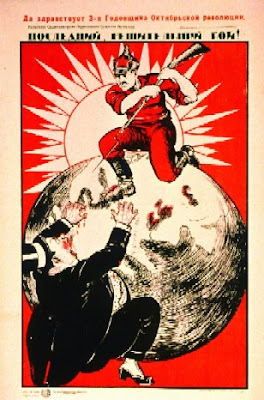The Classics, Part 10b
Role of Workers under the NEP – contemporary poster
The Role and Function of TUs under the NEP
“The proletarian state may, without changing
its own nature, permit freedom to trade and the development of capitalism only
within certain bounds, and only on the condition that the state regulates
(supervises, controls, determines the forms and methods of, etc.) private trade
and private capitalism. The success of such regulation will depend not only on
the state authorities but also, and to a larger extent, on the degree of
maturity of the proletariat and of the masses of the working people generally,
on their cultural level, etc. But even if this regulation is completely
successful, the antagonism of class interests between labour and capital will
certainly remain. Consequently, one of the main tasks that will henceforth
confront the trade unions is to protect in every way the class interests of the
proletariat in its struggle against capital. This task should be openly put in
the forefront, and the machinery of the trade unions must be reorganised,
changed or supplemented accordingly (conflict commissions, strike funds, mutual
aid funds, etc., should be formed, or rather, built up).”
Today’s text on the “Role and Function
of Trade Unions under the NEP” (1922) speaks unequivocally of “the duty of the trade unions to protect the
interests of the working people”, in both private and public enterprises. (Text
attached or downloadable the via the link below).
This will be our last classic of Lenin’s. It is one of
several classic documents of his that address the circumstances of the NEP -
the New Economic Policy - which was in place in the Soviet Union in the last
years of his life and for some years after his death. Others include “The Tax in Kind” (1921), “The Speech
at the Plenary Session of the Moscow Soviet” (1922) and “On Co-operation” (1923).
Lenin was ill from the start of the NEP, and progressively
more ill, finally bedridden and unable to speak for months until his death in January,
1924. The Civil War was also continuing until 1922. Later, the richer,
capitalising peasants or “kulaks” became demonised, correctly or not, and the
NEP came to an end around 1928. In Lenin’s view, the NEP was the correct
transitional arrangement. Large-scale industry was mostly in state hands, but
small businesses were privately owned.
Here in South Africa we do not yet have proletarian state
power in the way that the Russian workers obviously had it at the time of
Lenin’s writing of this text, 1922. But in other respects we have a similar set
of circumstances. Big-scale industry, whether in the hands of monopoly capital
or of the state, only employs a portion of those available for work, leaving a
very large portion of the population having to fend for itself, as
survivalists, entrepreneurs, SMMEs and all the rest of it.
Above all in South Africa, just as under the NEP in Russia
in the 1920s, the class struggle continues. Lenin is very frank about this. In
the end there is not going to be a win-win situation, and there is no win-win
along the way, either, but only class struggle with both winners and losers.
Here is an example of what Lenin had to say on this score:
“As long as classes
exist, the class struggle is inevitable. In the period of transition from capitalism
to socialism the existence of classes is inevitable; and the Programme of the
Russian Communist Party definitely states that we are taking only the first
steps in the transition from capitalism to socialism. Hence, the Communist
Party, the Soviet government and the trade unions must frankly admit the
existence of an economic struggle and its inevitability until the
electrification of industry and agriculture is completed—at least in the
main—and until small production and the supremacy of the market are thereby cut
off at the roots.”
Trade unions are all about “contact with the masses” and therefore cannot be sectarian:
“Under no
circumstances must trade union members be required to subscribe to any specific
political views; in this respect, as well as in respect of religion, the trade
unions must be non-partisan.”
The interest of the working class is “developmental” in a
material sense, namely in an “enormous
increase in the productive forces”. Lenin puts it like this:
”Following its seizure
of political power, the principal and fundamental interest of the proletariat
lies in securing an enormous increase in the productive forces of society and
in the output of manufactured goods.”
Lenin concludes:
“The Communist Party,
the Soviet bodies that conduct cultural and educational activities and all
Communist members of trade unions must therefore devote far more attention to
the ideological struggle against petty-bourgeois influences, trends and
deviations among the trade unions, especially because the New Economic Policy
is bound to lead to a certain strengthening of capitalism. It is urgently
necessary to counteract this by intensifying the struggle against
petty-bourgeois influences upon the working class.”
A NEP-like situation, which South Africa now has, and
arguably more so with the New Growth Path, involves a deliberate transitional
expansion of the petty-bourgeoisie, and therefore also requires a constant
struggle to maintain a “superstructure” over this petty-bourgeoisie. Such is
the lesson of Lenin in this case.
The formation and the growth of the proletariat will in due
course become determinant, because class struggle is the motor of history, and
because the proletariat is the gravedigger of capitalism. In the mean time, the
bourgeoisie and the petty bourgeoisie must continue with their historical role
of creating employment and thereby creating an ever-bigger and finally
overwhelmingly massive and politicised proletariat.
- The above is to introduce the original reading-text: Role and Functions of the TUs under the NEP, 1921, Lenin.
- To download any of the CU courses in PDF files please click here.













